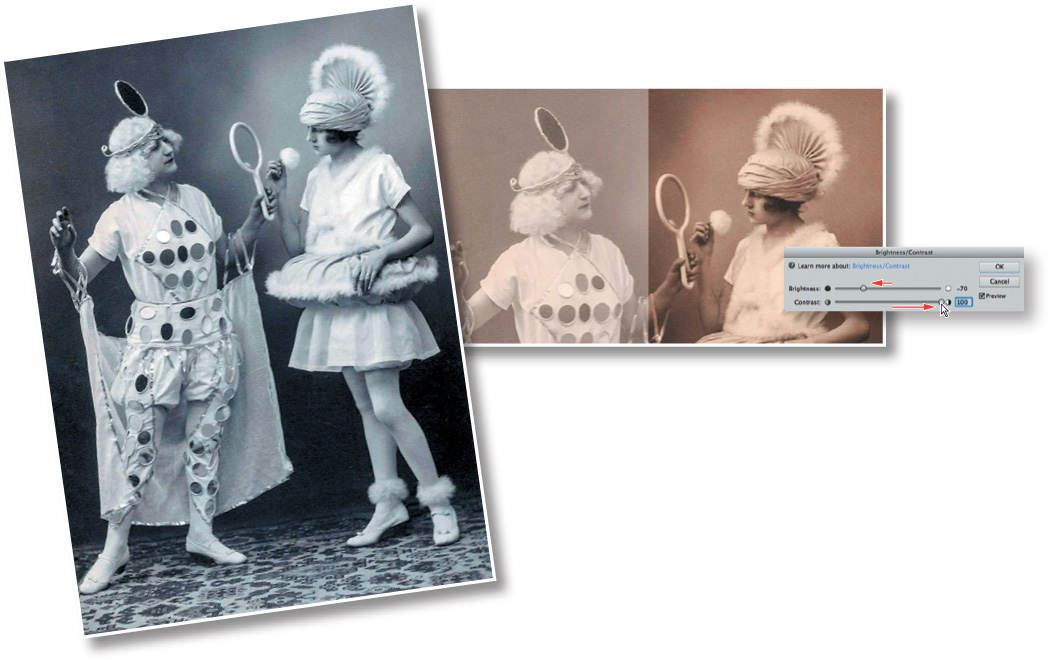6. Fixing Exposure Problems
Lesson overview
Photoshop Elements makes it easy to fix images that are too dark or too light and to rescue photos that are dull, flat, or simply fading away.
Start with Quick Fix and Guided edits, and work up to Expert mode as you learn how to make the most of poorly exposed images, retrieve detail from photos that are too dark or pale and faded, and liven up images that look flat and washed out. Photoshop Elements delivers powerful, easy-to-use tools for correcting exposure and lighting problems in all three Edit modes.
In this lesson, you’ll be introduced to a variety of techniques for dealing with a range of common exposure problems:
• Brightening underexposed photographs
• Correcting parts of an image selectively
• Saving selection shapes to re-use in later sessions
• Working with adjustment layers and layer masks
• Using layer blending modes and opacity settings
• Adjusting lighting controls manually
• Enhancing overexposed and faded photographs
You’ll probably need between one and two hours to complete this lesson. If you haven’t already done so, download the Lesson 6 work files from the Lesson & Update Files tab of your Account page at www.peachpit.com.
Learn how to make the most of images that were captured in unusual lighting conditions, retrieving detail from overly dark photos and putting the spark back into images that look dull or washed out. Find out how Photoshop Elements can help you save those faded memories—no matter what your level of experience—with a suite of powerful, easy-to-use tools and the versatility of three Edit modes.
Getting started
To start, you’ll import the sample images for this lesson to the CIB Catalog that you created at the beginning of Lesson 1.
![]() Note
Note
Before you start this lesson, make sure that you’ve set up a folder for your lesson files and downloaded the Lesson 6 folder from your Account page at www.peachpit.com, as detailed in “Accessing the Classroom in a Book files” in the chapter “Getting Started” at the beginning of this book. You should also have created a new work catalog (see “Creating a catalog for working with this book” in Lesson 1).
1. Start Photoshop Elements, and click Organizer in the Welcome Screen.
2. In the Organizer, check in the lower-right corner of the workspace to make sure the CIB Catalog is loaded—if not, choose File > Manage Catalogs, and select it from the list.
3. Click the Import button at the upper left of the Organizer workspace, and choose From Files and Folders from the drop-down menu. In the Get Photos and Videos from Files and Folders dialog, locate and select your Lesson 6 folder. Disable the automatic processing options; then, click Get Media.
4. In the Import Attached Keyword Tags dialog, click Select All; then, click OK.
Batch-processing the lesson files
As you’ve already seen, the batch-processing command lets you apply automatic adjustments to an entire folder of image files at once.
1. Before you start this lesson, set up automatic processing for the Lesson 6 images by following the steps in the exercise “Batch-processing the lesson files” at the beginning of Lesson 5.
2. At the end of each exercise in this lesson, compare the automatic fixes to the results that you achieve using various other techniques.
Adjusting images for tonal balance
Most image problems fall into two basic categories: color and exposure. In some photos, the two issues can be interrelated, and there is also some overlap in the tools and techniques you’ll use to correct them.
In the previous lesson, you gained experience recognizing and dealing with color deficiencies in your photos. This lesson will focus on exposure and lighting—issues that effect the tonal balance of your image.
Ideally, an image should have a good spread of tonal values from dark to light; any imbalance can result in a photo that is too dark or too light, has too little contrast or too much, or is lacking detail in the shadows, the midtones, or the highlights.
As with color correction, Photoshop Elements offers a range of tools for adjusting exposure, available in all three Edit modes. In the exercises to follow, you’ll look at a variety of ways to get the best from poorly exposed images, retrieve detail from photos that are too dark, and liven up images that look flat and washed out.
Brightening an underexposed image
Underexposed photographs look too dark or dull and flat, often across the entire image, but sometimes in just part of it. While the lighting auto-fixes do a good job with many photos, this exercise will teach you techniques to give you more control for adjusting the exposure in problem images.
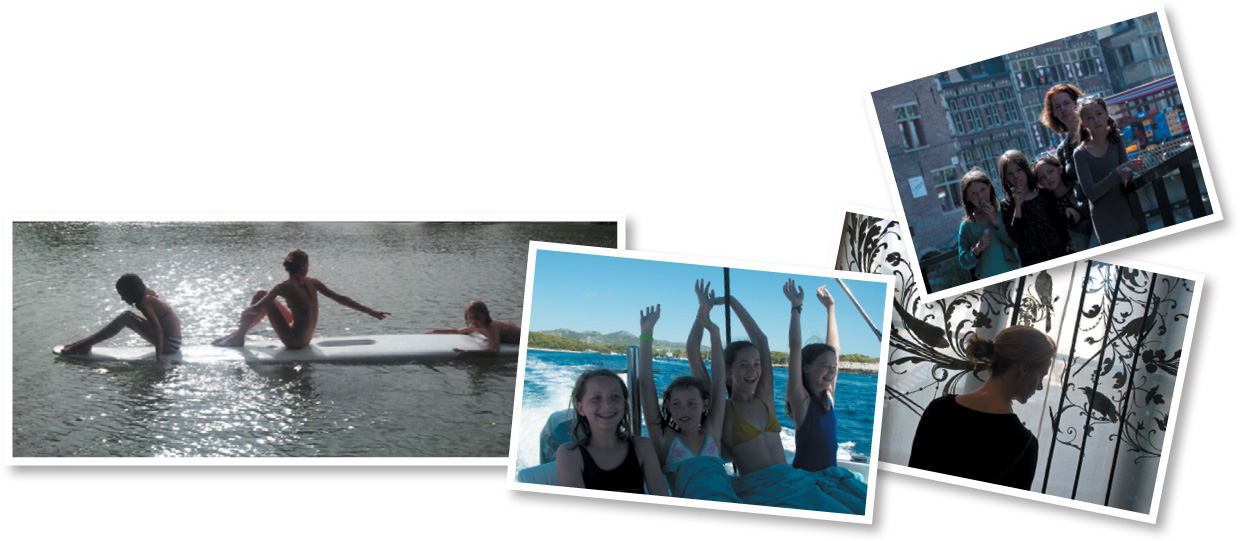
Applying Quick Fix lighting adjustments
Let’s start by combining Exposure and Levels adjustments in Quick edit mode.
1. If necessary, click the checkbox beside the Lesson 06 tag to isolate the lesson images. Select the file TooDark.jpg; click the Editor button (![]() ) in the Taskbar. In the Editor, click Quick in the mode picker to switch to Quick edit mode.
) in the Taskbar. In the Editor, click Quick in the mode picker to switch to Quick edit mode.
![]() Tip
Tip
Use the View menu above the Edit pane to switch between the After Only view and the Before & After views to help you assess the results of your adjustments as you work.
2. Expand the Exposure pane, and decrease the Exposure setting to -0.2. Although we do want to brighten the image, increasing Exposure blows out the clouds; decreasing it brings back some detail.
3. Expand the Lighting pane, and click the Shadows tab. Set the (lighten) Shadows value to 75. Increase the Midtones setting to 5 and the (darken) Highlights to 15.
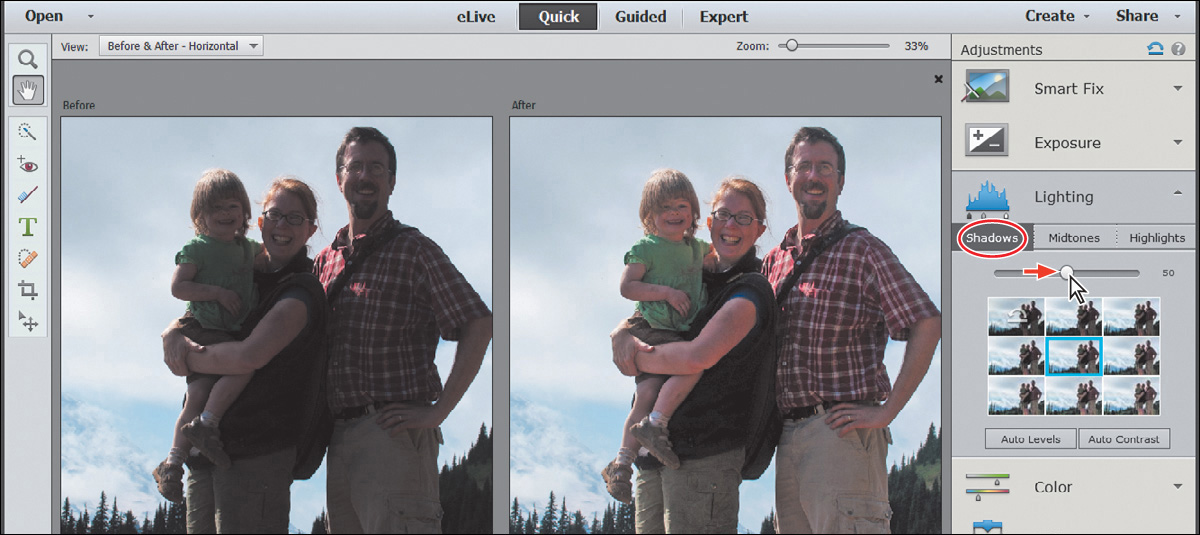
You’ve improved the image substantially with just a few clicks. However, though the skin tones have been lightened and have more definition, they are still a little cool.
4. Expand the Color pane. Click the Saturation tab, and reduce the value to -15. Expand the Balance pane. Set the Temperature value to 52.
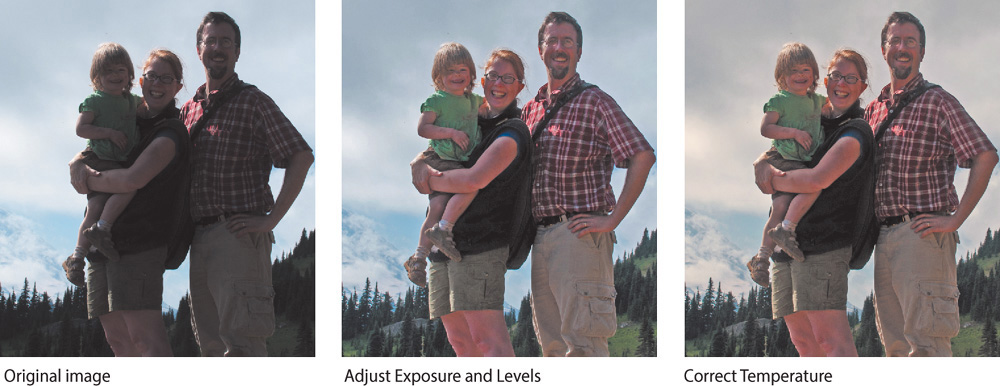
5. Choose File > Save. Make sure that Include in the Elements Organizer is selected and that Save in Version Set with Original is deselected. Name the new file TooDark_QuickEdit, to be saved to your My CIB Work folder in JPEG format. Click Save. In the JPEG Options dialog, use the slider to set the Quality to 9, and then click OK. Choose File > Close.
![]() Tip
Tip
In order to clearly demonstrate the effects of the various tonal controls on our lesson photo, some of the settings suggested in these exercises are quite extreme. If you wish, you can undo your steps, and then tweak the settings to your own taste before saving the results of each procedure.
Adjusting exposure in Guided edit mode
When you’re not sure exactly what adjustments a poorly exposed image needs, the Guided edit mode offers three procedures for correcting lighting and exposure: Brightness and Contrast, Levels, and Lighten and Darken—each with easy-to-follow prompts and instructions that make it simple for even a novice to get great results. You can improve your photos quickly at the same time as learning image-correction concepts and techniques that you can apply even in Expert mode.

1. In the Organizer, select the image TooDark.jpg in the Media Browser; then, click the Editor button (![]() ) in the Taskbar. Click Guided in the mode picker to switch the Editor to Guided edit mode. In the guided tasks menu, expand the Touchups category, if necessary; then, click Brightness and Contrast. Drag the sliders to decrease the Brightness setting to -30, and change the Contrast to 20 (to bring detail to the clouds and mountain); then, click Done at the bottom of the guided edit panel.
) in the Taskbar. Click Guided in the mode picker to switch the Editor to Guided edit mode. In the guided tasks menu, expand the Touchups category, if necessary; then, click Brightness and Contrast. Drag the sliders to decrease the Brightness setting to -30, and change the Contrast to 20 (to bring detail to the clouds and mountain); then, click Done at the bottom of the guided edit panel.
![]() Note
Note
In the guided edit panel, numerical values for the settings are displayed in tool tips when you click or move the slider controls.
2. Click the Levels guided edit in the Touchups list; then, click the Create Levels Adjustment button at the top of the guided edit panel. Click OK in the New Layer dialog to accept the default name for the new adjustment layer. Drag the gray midtones stop (below the center of the histogram curve) to the left to brighten the photo by setting the midtones value to 1.7. Click OK; then, click Done at the bottom of the guided edit panel.

3. Choose Lighten and Darken in the guided Touchups list. Set the Shadows, Highlights, and Midtones to 15, 10, and 20 respectively, and then click Done.
4. Choose File > Save As. Make sure that the new file will be saved to your work folder and included in the Organizer, but not in a version set. Change the file format from Photoshop to JPEG; then, name the new file TooDark_Guided. Click Save; then, click OK to close the JPEG Options dialog. Choose File > Close, and then click No/Don’t Save to avoid saving the changes to the original file.
![]() Note
Note
Strong lighting behind a foreground subject is a classic cause of exposure problems; a setting that achieves an adequate exposure level across the entire frame will often leave the subject underexposed. In our example, the bright sky and clouds behind our subjects contribute to the problem in this way; the sky and mountain are quite well-lit, while the lighting on the family’s faces is low and indirect.
Once again, the adjusted image looks considerably better than the original; however, it would be ideal if we could treat the people in the foreground separately from the brighter background, so that it doesn’t become overexposed.
Fixing exposure in Expert edit mode
If your photo is a difficult case, you might need to use more elaborate methods than those you’ve used in the Quick and Guided edit modes to achieve the best results. In Expert edit mode, you can work with multiple layers and blending modes, and also make selections to isolate specific parts of an image for special treatment.
Using blending modes
In a multilayered image file, each layer has its own blending mode that defines the way it will interact with any layer below it in the stacking order. By default, a newly created layer uses the Normal blending mode: It will not blend with the layers below it except where it contains transparency or when the master opacity for the layer is set to less than 100%. A layer with the blending mode set to Darken or Lighten will blend with the layers below it only where the result will darken or lighten the lower layers. Other blending modes produce more complex results.
![]() Tip
Tip
For information on the effects produced by the different layer blending modes, please refer to Photoshop Elements Help.
If a photo is too dark, applying the Screen blending mode to an overlaid duplicate of the background layer may correct the problem. If your photo is overexposed, an overlaid duplicate with the Multiply blending mode can be a solution. You can adjust the master opacity of the overlaid layer to control the intensity of the effect.
1. In the Media Browser, right-click/Control-click the image TooDark.jpg, and choose Edit with Photoshop Elements Editor from the context menu, taking care not to confuse the original file with the edited copies.
2. Switch to Expert mode by clicking Expert in the mode picker at the top of the Editor workspace. Choose Window > Reset Panels, and then hide the Photo Bin by clicking the Photo Bin button (![]() ) at the left of the Taskbar (twice, if necessary). Choose View > Fit On Screen.
) at the left of the Taskbar (twice, if necessary). Choose View > Fit On Screen.
3. In the Layers panel you can see that the image has only one layer: Background. Duplicate the Background layer by dragging it onto the New Layer button (![]() ) at the left of the Layers panel’s header.
) at the left of the Layers panel’s header.
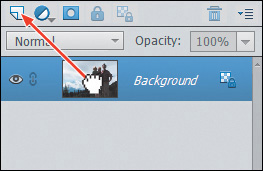
![]() Tip
Tip
You can also duplicate a selected layer by choosing Duplicate Layer from the Layer menu or by right-clicking/Control-clicking the layer and choosing from the layer’s context menu.
In the Layers panel, the new Background copy layer is highlighted to indicate that it is the currently selected—or active—layer.
![]() Tip
Tip
If the layer blending mode menu is disabled, make sure that you have the copy layer—not the original Background—selected in the Layers panel.
4. With the Background copy layer selected, choose Screen from the blending mode menu at the top of the Layers panel. The image becomes much brighter overall, but the people are still darker than we’d like. Reduce the opacity of the Background copy layer to 75%, and then duplicate it by dragging it onto the New Layer button. At the top of the Layers panel, set the second duplicate layer’s blending mode to Color Dodge and its opacity to 35%.
5. Choose File > Save. Name the new file TooDark_Blend, to be saved to your My CIB Work folder and included in the Organizer, but not as part of a version set. To preserve the layers you created, save the image in the Photoshop (PSD) file format and make sure the Layers option is activated, and then click Save.
6. To quickly compare the adjusted image to the original, toggle the visibility of the Background copy layers by clicking the eye icon (![]() ,
, ![]() ) beside each layer’s thumbnail. When you’re done, close the file without saving.
) beside each layer’s thumbnail. When you’re done, close the file without saving.

In this exercise, you’ve seen how you can use blending modes to brighten a dull image. For many photos, however—including our lesson image—applying blending modes over the entire image can adversely affect areas that were OK to begin with.
In our example, the sky in the background is now overly bright, and has lost almost all color and midtone detail. The resultant high-contrast glare of the blended background seems to dominate the less well-lit subjects in the foreground.
About adjustment layers
An adjustment layer affects the underlying layers like an overlay or lens filter, perhaps darkening the photo, perhaps making it appear pale and faded or intensifying its hues—but remaining separate from the image itself. Effects applied on an adjustment layer can be easily revised, or even removed, because the pixels of the image layers are not permanently modified. You can even copy an adjustment layer from one photo and paste it on top of the image layers in another—a real time-saver when you wish to apply the same treatment to several similar images.
![]() Note
Note
A new adjustment layer is always created immediately above the currently selected layer. For a one-layer image, the Background is active (selected) by default.
Using adjustment layers to correct lighting
In this exercise, you’ll try some different techniques to correct and enhance the same underexposed photo that you used for the last series of exercises.
1. In the Organizer, select the image TooDark.jpg in the Media Browser; then, click the Editor button (![]() ) in the Taskbar.
) in the Taskbar.

2. Click the Create New Fill or Adjustment Layer button (![]() ) in the header of the Layers panel, and choose Brightness/Contrast from the menu. In the panel, drag the slider, or type in the text box, to set a Brightness value of 75.
) in the header of the Layers panel, and choose Brightness/Contrast from the menu. In the panel, drag the slider, or type in the text box, to set a Brightness value of 75.
3. Click the Create New Fill or Adjustment Layer button again, this time choosing Levels from the menu. Notice the new Levels 1 adjustment layer in the Layers panel. The Adjustments panel is updated to present the Levels controls.

4. Select the middle of the three eyedropper tools at the right of the Levels controls, and sample a neutral gray in the rocks to the left of the woman. The gray-point eyedropper makes the color warmer, adding some life to the skin tones. Lighten the midtones by dragging the gray midtones stop under the center of the graph to the left to set a new value of 1.15.

5. Choose File > Save. Name the new file TooDark_AdjustLayers, to be saved to your My CIB Work folder and included in the Organizer, but not as part of a version set. To preserve the layers, save the image in the Photoshop (PSD) file format and make sure the Layers option is activated, and then click Save.
6. To quickly assess the effect of the adjustment layers, toggle the visibility of each layer by clicking the eye icon beside its thumbnail in the Layers panel. When you’re done, close the file without saving.
As long as you save the file in the Photoshop format, preserving the layers, you can return to adjust your settings at any time. Even after closing the file, the adjustment layers retain the values you set, and remain live; if necessary, you could even revert to the original image by either hiding or deleting the adjustment layers.
Correcting parts of an image selectively
Our adjustment layers brought out color and image detail from the overly dark foreground, but the background is now overexposed and lacking in tonal depth. So far in this lesson, all the corrections you’ve made have been applied to the entire image; in the next set of exercises you’ll selectively adjust just part of the photo.

Creating a selection
In this exercise, you’ll isolate our subjects in the foreground from the backdrop so that you can treat these two areas of the image separately. To start, you’ll select the combined silhouette of the family and save that selection.
You’ve already explored some of the many ways to make a selection in Lesson 5. We’ll start by revisiting the Quick Selection tool, which automatically determines selection borders based on similarity in color and texture.
1. Open the original image file TooDark.jpg once again.
2. In the toolbar, click the Quick Selection tool (![]() ), or whichever of its variants is currently visible at the right of the Lasso tool, and then click the Tool Options button (
), or whichever of its variants is currently visible at the right of the Lasso tool, and then click the Tool Options button (![]() ) in the Taskbar to access the tool settings. In the Tool Options pane, make sure that the New Selection mode is activated for the Quick Selection tool. Set a brush diameter of around 100 px (pixels), and select Auto-Enhance.
) in the Taskbar to access the tool settings. In the Tool Options pane, make sure that the New Selection mode is activated for the Quick Selection tool. Set a brush diameter of around 100 px (pixels), and select Auto-Enhance.

3. Starting in the lower-right corner, drag to the left along the bottom of the photo to select the forested area; then, drag up over each of the people to create a rough selection surrounding all the foreground elements. With each stroke, the selection automatically expands to include more of the combined silhouette.

Next, you need to refine the selection border to capture the silhouette as closely as possible. You’ll need to deselect the small areas of background that are visible between arms and torsos, and pay extra attention around the edges of the hair.
While refining your selection, you can alternate between the Quick Selection tool’s Add to Selection and Subtract from Selection modes by holding down either the Shift key or the Alt/Option key. To reduce or increase the brush size as you work, without using the Tool Options pane, press the left and right bracket keys ( [ and ] ).

4. Keeping the Quick Selection tool selected, hold the Ctrl/Command key, and press the plus sign (+) to zoom in. Hold the spacebar, and drag the image to focus on the gap between the man’s arm and torso.
5. Press the left bracket key ( [ ) on your keyboard repeatedly to reduce the brush size to 30 px. Drag in the unwanted fragment of background, holding down the Alt/Option key to operate the Quick Selection tool in Subtract from Selection mode. The selection contracts to exclude the extraneous area. Reduce the brush size further, and alternate between the Alt/Option and Shift keys, using clicks and short strokes to refine the selection border around the deselected area.
6. Without being overly fussy, continue to refine the selection around the subjects’ edges. Your work will be much easier if you use the keyboard shortcuts detailed above to navigate in the image and adjust the tool settings. Unless you have a lot of time on your hands, you can exclude the tops of the tree branches.
![]() Tip
Tip
Take a moment to move the pointer over each control in the Refine Edge dialog in turn to see a description of its action, displayed in a tool tip.
7. To smooth and soften the edges of the selection, choose Select > Refine Edge. Alternatively, you could show the Tool Options pane and click the Refine Edge button. In the Refine Edge dialog, activate the Smart Radius option for the Edge Detection control, and set the Radius to 2 px. Under Adjust Edge, set the Smooth value to 2. Under Output, make sure the Output To option is set to Selection.

8. While you’re working on refining your selection, you can preview the results against a variety of backgrounds, each helpful in different circumstances. Under View Mode, click the View button. Move the pointer over each of the seven preview options to see a tool-tip description, and then click each option in turn to see the result in the Edit window.

9. Click OK to apply your edge refinement settings to the selection; then, choose Select > Save Selection. In the Save Selection dialog, choose New from the Selection menu, type Family for the selection name, and then click OK. Once a selection is saved, you can always re-use it—after assessing your adjustments, you can reload the selection to modify them. Choose Select > Deselect.
Using layer masks to isolate parts of an image
Now that you’ve created a selection including only the figures in the foreground, you can adjust the exposure and lighting for the subjects and the background independently. You could use your selection (even at a later date, now that you’ve saved it) to temporarily isolate part of the image for editing. Instead, you’ll use the saved selection to create separate layer masks for the different areas in the image.
A layer mask can be permanently linked to a particular layer in an image, so that any modification made to that layer will be applied only through the mask. The parts of the layer protected by the layer mask are hidden from view when it’s blended with the other layers in your image. Layer masks can be edited by painting and erasing, so you can add to or subtract from a layer mask (and thereby, add to or subtract from the area that will be modified by an editing operation) without affecting the image pixels on the layer to which the mask is attached.
1. Duplicate the Background layer by dragging it onto the New Layer button (![]() ) at the left of the Layers panel’s header.
) at the left of the Layers panel’s header.
2. Click the menu icon (![]() ) at the far right of the Layers panel’s header to open the Layers panel Options menu; then, choose Panel Options. In the Layers Panel Options dialog, select either large or medium thumbnails—seeing the layer thumbnails can help you visualize the layers you’re working with. Click OK. If necessary, choose View > Fit on Screen so that you can see the entire image.
) at the far right of the Layers panel’s header to open the Layers panel Options menu; then, choose Panel Options. In the Layers Panel Options dialog, select either large or medium thumbnails—seeing the layer thumbnails can help you visualize the layers you’re working with. Click OK. If necessary, choose View > Fit on Screen so that you can see the entire image.
3. Choose Select > Load Selection. Choose the saved selection Family from the Source Selection menu, click the checkbox to activate the Invert option, and choose New Selection under Operation; then click OK.
4. Make sure the Background copy layer is still selected, and then click the Add Layer Mask button (![]() ) at the top of the Layers panel.
) at the top of the Layers panel.
A mask thumbnail appears on the Background copy layer, showing that your active selection in the image window has been converted to a layer mask on that layer. The blue frame around the mask thumbnail indicates that the mask is currently selected—any change you make right now will modify the mask, not the image pixels on this layer.

![]() Tip
Tip
Edits made on a masked layer will be applied at full strength through the white parts of the mask; black areas in the mask represent the parts of your image that are completely protected. A gray area will allow a modification to be applied at a strength equivalent to the percentage of white present; a layer mask containing a gradient from white to black can be a great way to fade one image into another.
5. Alt-click/Option-click the layer mask thumbnail to make the mask visible in the Edit window. With the mask selected, as it is now, you can edit it using painting and selection tools—or even the Text tool. Alt-click/Option-click the layer mask thumbnail again to hide the mask.
6. Click the image thumbnail on the masked layer; then click the eye icon beside the image thumbnail on the original Background layer to make the layer temporarily invisible. You can see that the protected areas of the masked layer are actually hidden from view. Make the Background layer visible again.
While this layer mask is active, any change made to the original Background layer will be visible only in the figures in the foreground; any change you make to the masked layer will be applied only to the backdrop around them.
7. Make another copy of the original Background layer by dragging it onto the New Layer button (![]() ) at the left of the Layers panel’s header bar. Choose Select > Load Selection. Select your saved selection, Family, as the Source Selection, but this time, leave the Invert option disabled. Under Operation, choose New Selection; then click OK.
) at the left of the Layers panel’s header bar. Choose Select > Load Selection. Select your saved selection, Family, as the Source Selection, but this time, leave the Invert option disabled. Under Operation, choose New Selection; then click OK.
8. Make sure the new layer, Background copy 2, is still selected, and then click the Add Layer Mask button (![]() ) at the top of the Layers panel. Repeat steps 5 and 6 for the new mask layer.
) at the top of the Layers panel. Repeat steps 5 and 6 for the new mask layer.
If you keep the layer masks linked to the Background copy layers as they are now, they will remain editable. For the purposes of this exercise, however, we’ve already refined our selection, and we have no other reason to keep the mask active.

9. Right-click/Control-click each black-and-white layer mask thumbnail in turn, and choose Apply Layer Mask from the context menu.
The layer masks can no longer be edited; they have been permanently applied to their respective layers. The layer mask thumbnails have now disappeared, and the image thumbnails show areas of transparency, indicating protected areas on those layers.
10. You’ll find it much easier to deal with layers—especially when you’re working with many of them—if you give your layers descriptive names in the Layers panel. Double-click the name text of Background copy 2, and type Family as the new name for the layer. Change the name of Background copy to Sky.
Correcting underexposed areas
We can now apply a slightly adjusted version of the most effective brightening technique from the earlier exercises to the subjects of our photo—selectively.
1. In the Layers panel, make sure the Background layer is visible; then, select the Family layer. Choose Screen from the blending menu, and set the opacity to 75%.
2. Duplicate the Family layer. Set the blending mode for the new layer to Color Dodge and the opacity to 35%. Choose Enhance > Adjust Lighting > Shadows/Highlights, and set Lighten Shadows to 50%. The figures in the foreground are brighter and clearer, while the background remains unaffected. Click OK.

Adding more intensity
Now that the figures in the foreground look so much better, we can work to make the mountain and sky more interesting.
With the foreground and background isolated on separate masked layers, you’re free to apply whatever modifications you choose. There are no hard-and-fast rules; you might decide to emphasize the figures by making the background bright and pale, or by making it darker and more dramatic. For the purposes of this exercise, we’ll boost the colors and textural detail, making the background less bright while preserving the lighting dynamics of the original image.
1. In the Layers panel, select the Sky layer. Choose Enhance > Adjust Color > Adjust Hue/Saturation. Increase the Saturation setting to 50 and the Lightness to 15. Click OK. Choose Enhance > Adjust Lighting > Brightness/Contrast; then, set the Brightness to -20 and the Contrast to 15. Click OK.

The background looks clearer and more vibrant, while the soft contrast prevents it from overwhelming the figures in the foreground.
With these few adjustments to the separate layers, the photograph now looks far more lively. There are still possibilities for improving the separated areas of the image; for example, you could apply a Gaussian blur to the background to create a depth-of-field effect. There’s also more you could do with blending modes and layer opacity. You’ll learn more of these techniques as you work through this book.
2. Choose File > Save. Make sure that Include in the Elements Organizer is activated and that Save in Version Set with Original is deselected. Name the new file TooDark_LayerMasks, and choose the Photoshop (PSD) format. Make sure the Layers option is selected, and then click Save. If the Format Options dialog appears, select Maximize Compatibility, and click OK. Close the file.
3. In Lesson 5 you learned how to tile the image windows to best compare the results of different correction methods. Use that technique now to compare the adjusted and saved versions of this photograph before moving on.

Improving faded or overexposed images

In this section, you’ll work with the scan of a family keepsake in need of restoration. This badly faded photo has problems similar to those found in overexposed images, and will respond to the same correction techniques.
The automatic fixes applied to a copy at the beginning of this lesson improved the image markedly, but also removed the characteristic sepia tint, treating it as a color cast. In this project, you’ll try to do even better, using other correction techniques while preserving the evocative antique look.
1. In the Organizer, isolate the Lesson 6 images, if necessary. In the Media Browser, select the file TooLight.jpg; then, click the Editor button (![]() ) in the Taskbar.
) in the Taskbar.
2. If the Editor is not already in Expert mode, click Expert in the mode picker.
3. If you don’t see the Photo Bin, show it by clicking the Photo Bin button (![]() ) at the left of the Taskbar. If you don’t see the filename beneath the thumbnail in the Photo Bin, right-click/Control-click the thumbnail, and choose Show Filenames. Choose Window > Reset Panels, and then View > Fit On Screen.
) at the left of the Taskbar. If you don’t see the filename beneath the thumbnail in the Photo Bin, right-click/Control-click the thumbnail, and choose Show Filenames. Choose Window > Reset Panels, and then View > Fit On Screen.
Creating a set of duplicate files
You’ll compare a variety of editing techniques during the course of this project. You can begin by creating a separate file to test each method, named for the technique it will demonstrate.
1. Right-click/Control-click the thumbnail image in the Photo Bin, and choose Duplicate from the context menu. In the Duplicate Image dialog, name the file TooLight_Shad-High; then, click OK. Repeat the process to create two more copies, with the names TooLight_Bright-Cont and TooLight_Levels.
2. In the Photo Bin, double-click the thumbnail TooLight.jpg to make that image active and bring its image window to the front. If you can’t see the entire filename under a thumbnail in the Photo Bin, hold the pointer over the thumbnail; the name of the file is displayed as a tool tip.
3. Choose File > Save As. Select your My CIB Work folder as the destination for the new file; then select the option Include In The Elements Organizer, and deselect Save In Version Set With Original. Type TooLight_Blend-Modes as the new filename, and choose Photoshop (PSD) from the Format menu. Click Save. Leave all four images open for the rest of this project.
Using blending modes to fix a faded image
The blending mode applied to a layer can make it interact with the layers beneath it in a variety of ways. The Multiply mode intensifies or darkens pixels in an image. The Overlay mode tends to brighten the image while preserving its tonal range.
1. Make sure that TooLight_Blend-Modes.psd is still the active image. If necessary, double-click its thumbnail in the Photo Bin to make it active. In the Layers panel, right-click/Control-click the Background layer, and choose Duplicate Layer from the context menu. Click OK in the Duplicate Layer dialog to accept the default name “Background copy.”
2. In the Layers panel, choose Multiply from the layer blending mode menu. Note the effect in the image window. Drag the Background copy layer with its Multiply blending mode onto the New Layer button (![]() ) at the top of the Layers panel to create a copy of the Background copy layer.
) at the top of the Layers panel to create a copy of the Background copy layer.
3. Change the blending mode for the layer Background copy 2 from Multiply to Overlay, watching the effect on the image. Set the layer’s Opacity value to 50%, either by dragging the Opacity slider or by typing the new value in the text field.

Adding a layer with the Multiply blending mode made the image bolder, and then the third layer, in Overlay mode, brightened it considerably and improved definition. Taken together, your changes have made the photo clearer, but the contrast in parts of the image, particularly in the lighter clothing, is still unimpressive.
4. Choose File > Save to save the file in your My CIB Work folder, leaving the image open. If a message appears about maximizing compatibility, click OK to close it, or follow the instructions in the message to prevent it from appearing again.
Adjusting shadows and highlights manually
Although both the Auto-fix and blending modes do a good job of correcting many fading images, some of your own photos may be more challenging. You’ll try three more techniques in the exercises to follow. The first involves manually adjusting the shadows, highlights, and midtone contrast of the image.
![]() Tip
Tip
To identify a photo in the Photo Bin, hold the pointer over the thumbnail; the name of the file is displayed as a tool tip.
1. In the Photo Bin, double-click TooLight_Shad-High to make it the active image.
2. Choose Enhance > Adjust Lighting > Shadows/Highlights. If necessary, move the Shadows/Highlights dialog so that it doesn’t obscure the image window. Make sure that the Preview option is activated.
By default, the Lighten Shadows setting is 35%. You can see the effect on the image by toggling the Preview option on and off in the Shadows/Highlights dialog.
3. In the Shadows/Highlights dialog, set the Lighten Shadows value to 5%, the Darken Highlights value to 25%, and the Midtone Contrast to +75%.
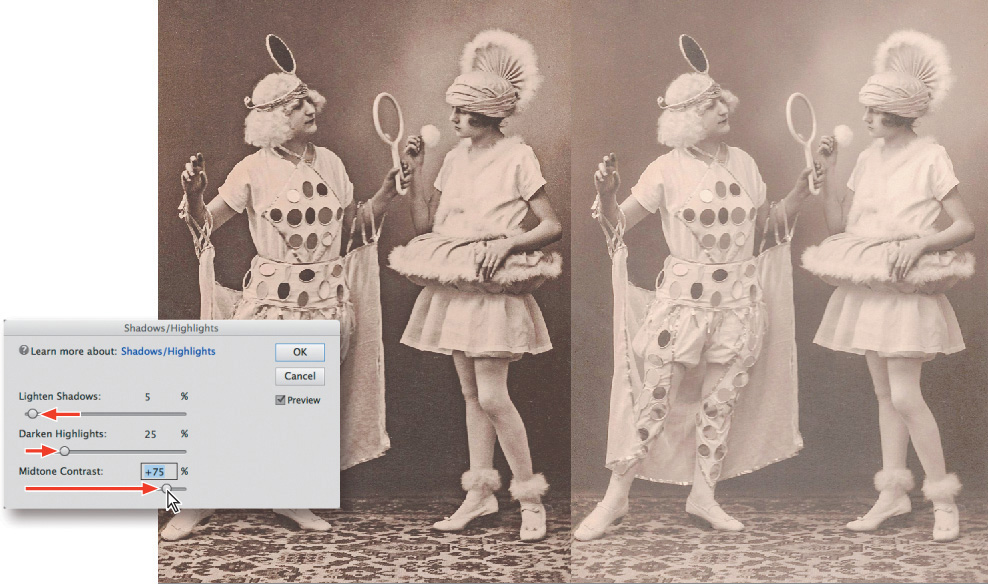
4. Adjust the three settings as needed until you think the image is as good as it can be. When you’re done, click OK to close the Shadows/Highlights dialog.
5. Choose File > Save, and save the file to your My CIB Work folder, in JPEG format. Make sure that the image will be included in the Organizer, but not in a version set. Click Save, and then click OK in the JPEG Options dialog, and leave the file open.
![]() Tip
Tip
The controls you are using to make the adjustments for this technique are also available in the Lighting panel in Quick Fix mode.
Adjusting brightness and contrast manually
The next approach you’ll take to fixing an exposure problem makes use of another option from the Enhance > Adjust Lighting menu.
1. In the Photo Bin, double-click the image TooLight_Bright-Cont to make it active. If necessary, choose View > Fit On Screen or double-click the Hand tool.
2. Choose Enhance > Adjust Lighting > Brightness/Contrast. If necessary, drag the Brightness/Contrast dialog to one side so that it doesn’t block your view of the image. Make sure that the Preview option is activated so you can see the effects of your adjustments on the photo as you make them.
3. Drag the Brightness slider to -70, or type -70 in the text field, being careful to include the minus sign when you type. Increase the Contrast to 100.
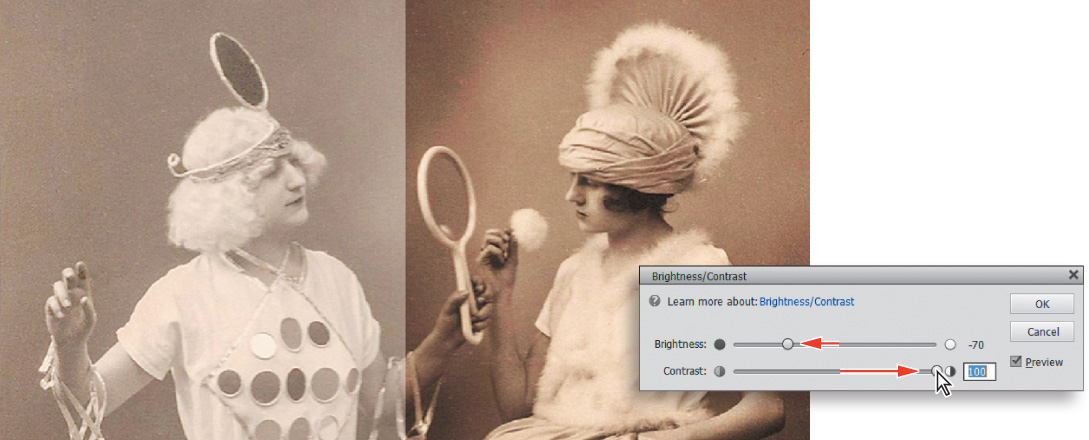
4. Adjust the Brightness and Contrast settings until you are happy with the look of the image. Click OK to close the Brightness/Contrast dialog.
5. Choose File > Save, and save the file to your My CIB Work folder, in JPEG format. Make sure that the image will be included in the Organizer, but not in a version set; then, click Save. Click OK in the JPEG Options dialog, but keep the file open. Choose Window > Images > Tile.
Adjusting levels
The Levels controls affect the distribution of tonal values in an image—the range of tones from dark to light, regardless of color. In this exercise, you’ll enhance the image by shifting the reference points that define the spread of those tonal values.
1. In the Photo Bin, double-click the image TooLight_Levels to make it active. Choose Window > Images > Float in Window; then double-click the Hand tool.
2. Choose Enhance > Adjust Lighting > Levels. Select the Preview option in the Levels dialog, if it is not already active. If necessary, drag the Levels dialog aside so that you can see most of the image window.
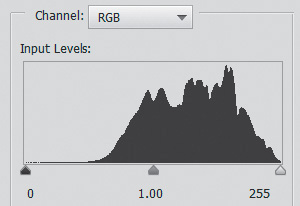
The Levels graph represents the distribution of tonal values across all the pixels in the image, from darkest at the left to lightest at the right. A trough (or gap) in the curve indicates that there are few (or no) pixels mapped to that part of the range; a peak shows the opposite.
As you can see from the graph, this image has no black pixels, very few tones of less than 40% brightness; most of the image information is clustered at the light end of the scale.
3. In the Levels dialog, drag the black triangle below the left end of the graph to the right; the value in the first Input Levels box should be approximately 80. Drag the white marker from the right side of the graph until the value in the third Input Levels box is approximately 245. Drag the gray marker to set the midtone value to approximately 0.75. Click OK to close the Levels dialog.

4. Choose File > Save, and save the file to your My CIB Work folder in JPEG format as TooLight_Levels. Make sure that the image will be included in the Organizer, but not in a version set. Click Save; then, click OK in the JPEG Options dialog, and leave the file open.
Comparing results
You can now compare the six versions of the image: the original file, the four files you edited, and the image that was fixed automatically at the start of this lesson.
1. Choose File > Open. Locate and open the file TooLight_Autofix.jpg from the My CIB Work folder; repeat the process for the original file from your Lesson 6 folder, TooLight.jpg. The Photo Bin should show six open files.
2. Click the Photo Bin button in the Taskbar to hide the Photo Bin; then, hide the Panel Bin by deselecting its name in the Window menu.
3. Choose Window > Images > Tile. Use the Zoom and Hand tools to position the photo in any of the image windows so that you can see enough of the image to enable you to make a comparison of the different treatments; then, choose Window > Images > Match Zoom and Window > Images > Match Location.
4. Choose File > Close All. Save any changes to your CIB Work folder if you’re prompted to do so.
Congratulations! You’ve finished another lesson. Before you move on to the next chapter, take a few moments to review what you’ve learned by reading through the questions and answers on the next page.
Review questions
1. How can you create an exact copy of an existing layer?
2. Where can you find the controls for adjusting the lighting in a photograph?
3. How can you arrange multiple image windows in the work area automatically?
4. What is an adjustment layer and what are its unique advantages?
Review answers
1. You must be in Expert mode to copy a layer. Select a layer in the Layers panel, and choose Layer > Duplicate Layer. You can access the same command in the Layers panel Options menu or by right-clicking/Control-clicking the layer in the Layers panel. Alternatively, drag the layer to the New Layer button. Whichever method you use, you get two layers identical in all but their names, stacked one above the other.
2. You can adjust the lighting for a photo in Expert, Guided edit, and Quick edit modes. In Expert mode, you can use the Enhance > Adjust Lighting menu to open various dialogs that contain the controls. Alternatively, you can choose Enhance > Auto Levels, Enhance > Auto Contrast, or Enhance > Adjust Color > Adjust Color Curves. In Guided edit mode, choose the Brightness and Contrast, Levels, or Lighten and Darken operations from the Touchups category. In Quick edit mode, you can use the Exposure and Lighting panes in the Quick Fix panel.
3. You cannot rearrange image windows in Quick edit and Guided edit modes, which display only one photograph at a time. In the Expert workspace, there are several ways you can arrange them. Choose Window > Images, and select one of the choices listed there—you can access some of the same options, and several more, by clicking the Layout button in the Taskbar. Some of the options require that you enable floating windows in Expert mode, which can be done in the Preferences dialog.
4. An adjustment layer does not contain an image; instead, it modifies some quality of all the layers below it in the Layers panel. For example, a Brightness/Contrast layer will alter the brightness and contrast of any underlying layers. One advantage of using an adjustment layer instead of adjusting an existing layer directly is that adjustment layers can be easily modified or even removed. Toggle the eye icon for the adjustment layer to remove or restore the edit instantly. You can change a setting in an adjustment layer at any time—even after the file has been saved. An adjustment layer can also be copied and pasted into another image to apply the same settings there.

